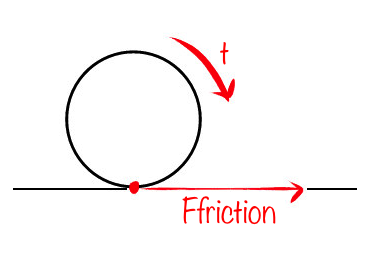The wheel with mass $M$ and radius $R$ below is free in space (it is not on the ground). A torque $\tau$ is applied to it through an engine. A horizontal force $F = \frac{\tau}{R}$ is also applied to it on its bottom-most point. I work out the net torque on the wheel by
$$\tau_{net} = \tau - \frac{\tau}{R}R = 0$$
Since the net torque acting on the wheel is zero, I expect the wheel to slide to the right with linear acceleration $a = \frac{\tau}{MR}$, and to not roll (due to zero torque).

Now, another wheel (below) with radius $R$ is on the ground, and an engine applies a torque $\tau$ to it. The ground applies a force $F_{friction}$ in order to prevent the wheel to slip. The wheel translates to the right, but this time let's say that it rolls with a bit of slipping.

From this, can I assume that the friction force $F_{friction}$ the ground applies to the wheel is always smaller than $\frac{\tau}{R}$? Because, from what I see above, if friction is equals to this $\frac{\tau}{R}$, the wheel would not roll at all.
